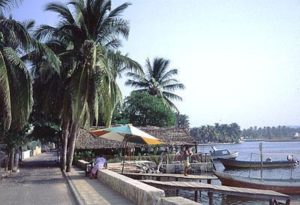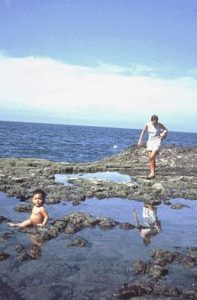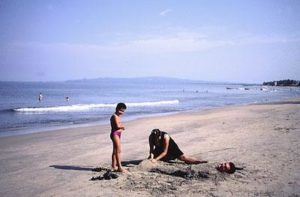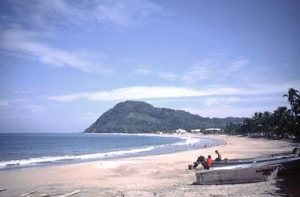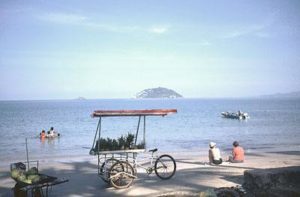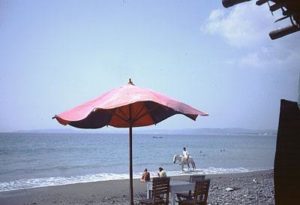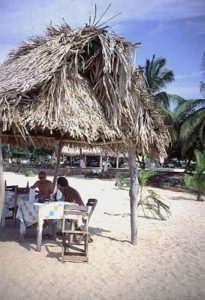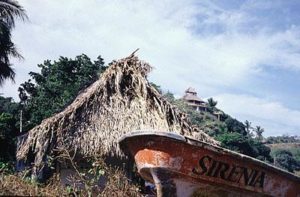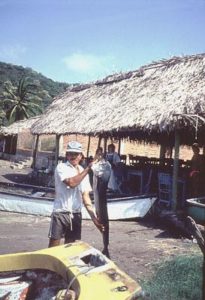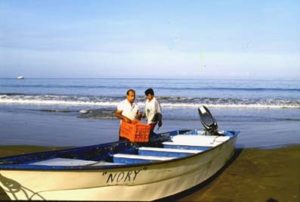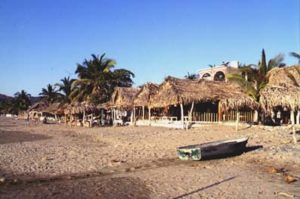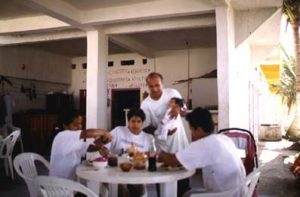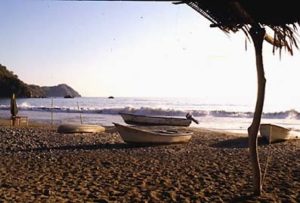Squatting on the rocky cliff high above the bay, two young boys watched the man below who, knee deep in water, held his net ready. Suddenly, the boys yelled and pointed to a school of fish swimming behind the fisherman. As the man cast his small net, the boys clamored down the hill and flipped several fish into their plastic bags. Then, they reclaimed their lookout.
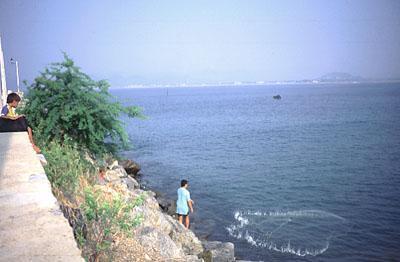
I was taking an after-breakfast walk along the breakwater in the sheltered cove of Barra de Navidad, on Mexico’s Pacific Coast. I had flown into Puerto Vallarta and then set out by bus — with a backpack, duffle bag, and full ration of naivete.
During my two-week visit, I headquartered in two towns — Barra de Navidad, south of Puerto Vallarta, and Rincon de Guayabitos, to the north. Buses run from these small resort towns to secluded beaches and rustic fishing villages.
The various villages differ in size and ambiance, but all share a common trait. They’re situated in coves, protected from the Pacific Ocean by steep, rocky, and jungly hillsides.
There wasn’t much to do in these villages, except walk along the beach and swim. In most of them, I found a palapa or two that served home-cooked meals and cerveza. In the Mexican tradition, I sat for hours sipping and snacking, not pressured to leave or order more food and drink. On occasion, I had to wait until after siesta to get my check, because the person on duty was snoozing.
Offshore, shrimp boats resembled gigantic pre-historic insects lazing in the sun. Early in the morning, small dinghys shuttled to the fishing rigs, bringing back fish to sell on the beach.
One morning, as I watched one of these itinerant fish markets, a young Mexican woman advised me in halting English, “Be sure to look at their eyes. Only buy the ones with sparkles in their eyes.” Her unsolicited, friendly advice was typical of the general attitude I encountered. The Mexicans either ignored, accepted, or looked at me curiously.
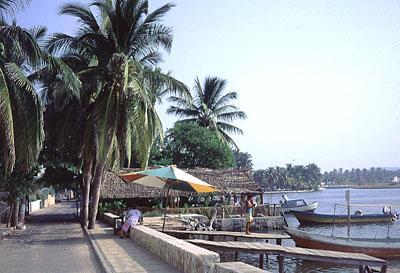
The coast is wonderfully undeveloped, and bus travel is surprisingly easy. Warned about Mexican buses by family and friends, I braced for hours of bumpy, pot- holed roads. I expected hair-curling spins around corners, and terrifying drives along cliffs. I wasn’t disappointed. However, the destinations made the rides worthwhile.
Clickable interactive map of Pacific Coast beaches: Jalisco, Nayarit, Colima, Michoacán, Mexico
I traveled only a few miles each day, exploring a new beach and village, sometimes flagging down commuter buses on the highway.
Maneuvering in the bus terminals was tricky, since I speak very little Spanish. I got information by pointing to a map, or writing where I wanted to go. The clerk would write the time of departure.
Times didn’t matter a whole lot, however, as buses run frequently — and sometimes not according to schedule at all. One ticket seller told me, 8.a.m “más o menos.”
I saw only a few other English-speaking travelers on the buses. Bus travel is not a touristy business. Sometimes, my lack of Spanish annoyed the clerks. But generally they were helpful, tapping me on the shoulder when my bus arrived. Bus drivers made sure I got off at the right place.
Following is a description of off-the-beaten-path beaches I visited, and tips in case you want to do it yourself.
Tips
- I traveled in October when it was uncrowded, so I had a wide selection of places to stay. I prefer to shop around for lodging rather than making advance reservations, which is difficult to do from the states, except in the more upscale and well-known areas.
- Unlike many Mexican destinations, Puerto Vallarta doesn’t have a central bus station. Rather, each bus line has its own terminal. I tell you the particular bus lines I rode on, but others travel the same route. You can find the terminals, in downtown Puerto Vallarta, by asking taxi drivers or people on the street.
- I haven’t included bus fares, because the amounts are minimal.
- Since these are not touristy places for U.S. vacationers, I suggest that women wear skirts and men wear long trousers, except, of course, on the beach. The Mexicans in these villages and on the buses don’t wear shorts.
- The Pacific Mexico Handbook by Bruce Whipperman is a detailed and much-appreciated guide to this area.
Rincon de Guayabitos
Located about 40 miles north of Puerta Vallarta, this is a well-kept, charming beach resort for vacationing Mexicans. Busloads arrive from Guadalajara on weekends and holidays, sometimes doubling its population of 4,000. At other times, even during mid-winter, they say it’s not very crowded.
Two streets parallel the beach. Along the business boulevard, Avenida del Sol Nuevo, are patio restaurants, gift shops, and modest bungalows with kitchenettes. Footpaths lead from the main street to the beach at every block.
Vendors, pushing colorful canopied carts, roam the beach serving pineapple and coconut drinks. Shaded by tarps, families cook fish on outdoor grills, and their children peddle “fish on a stick” — cooked to a crisp.
The wide, two-mile long beach offers a variety of ambiances. Restaurants and tourist activities (boat rides, lunch trips to the offshore island) are at the south end. To the north, it’s less crowded, lined with luxury resort hotels and oceanfront mansions.
Norteamericanos, mostly retirees, occupy several beachfront trailer parks. The men fish in the morning, and happy hour usually starts in mid-afternoon.
To get there
There is now a new central bus station near the airport in Puerto Vallarta, called the Central Camionera. From here, you can get a bus north to Rincon de Guayabitos and south to Barra de Navidad and Manzanillo. In fact, you can get a bus to just about anywhere in Mexico from this station.
Lodging
There are moderate accommodations in Rincon de Guayabitos. Hotel Posada La Misión on the beach offers romantic Old World charm created by colorfully tiled walls, floors, and archways. Villas Buena Vida offers waterfront suites with kitchenettes. There are dozens of less expensive bungalows along both of the main thoroughfares.
Restaurants
Posada La Misión in the hotel caters to English-speaking travelers and attracts visitors from the U.S. and Canada. I liked to snack at sidewalk cafes, where I sat for hours eating antijitos such as acos, pozole (a pork and hominy soup), or quesadillas.
Most accommodations in Rincón Guyabitos have cooking facilities. (They call these kind of rooms “bungalows.”) You can buy groceries in the supermarket and convenience stores. Streetside vendors sell hamburgers and hot dogs.
La Peñita
This bustling business center is two miles north of Rincón de Guayabitos. Along its wide, tree- shaded main boulevard are myriad stores, a bank, fruit and vegetable stands, and bus terminal. Taxis shuttle between the towns. Although it has a more commercial ambience than Rincón de Guayabitos, its beach is less touristy. It’s possible to walk along the beach from Guayabitos to La Peñita. About halfway, it’s necessary to go out to the highway to cross the inlet.
Playa Los Ayala
About a mile from Rincón de Guayabitos, heading south along Avenida del Sol Nuevo, is the small fishing village of Los Ayala. Many of the service people who work in the resort hotels live in Playa Los Ayalas. I walked there, but buses and taxis also run this route. This beach is lined with palapas and offers swimming in calm waters
Playa del Beso
By following a 10-minute trail through the jungle (visible at the far end of the beach at Playa Los Ayalas beach), I came to Playa del Beso, the Kissing Beach. From this secluded cove, fish flipping in the bay look like silver blades slicing the calm blue waters. You’ll probably have the beach to yourself.
Playa Lo de Marcos
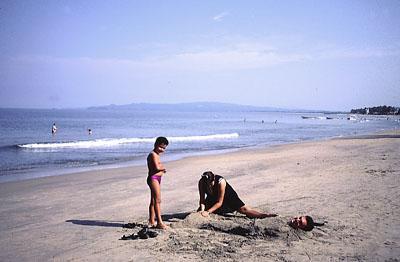
To get to the beach, I walked about a mile from the bus stop on Highway 200, along the town’s main street. Large homes, and a private club take up most of beachfront, giving this area an upscale look. Mexican families picnicked and played in the calm water at the south end. No beach palapas here, but patio restaurants line the main street.
To get there
Take the northbound bus from the Central Caminara in Puerto Vallarta, and get off at Highway 200 at Playa Lo De Marco, about 30 miles. I flagged down a southbound bus on Highway 200 at Rincón de Guayabitos. From here, Playa Lo De Marcos is eight miles south.
Las Minitas
A dirt road parallels the beach at Playa Lo De Marco leading to Las Minitas, a fishing village with many beach palapas. You can also hike there in 15 minutes, following a trail over the jungly hill that separates the two beaches
Playa El Venado
Continuing along the dirt road for half a mile past Las Minitas, I came to this remote beach, frequented by campers and surfers. There were several camping trailers parked on the road above the beach. A few surfers rode the crashing waves as lovers snuggled in the shade of a tree. There were no palapas for food and drink, but there’s a restaurant that’s probably open during the winter season.
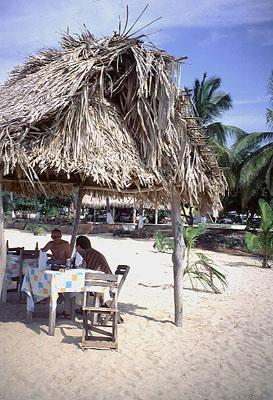
Sayulita
Located halfway between Puerto Vallarta and Rincon de Guayabitos, this fishing village has dusty streets and a beach of black sand, peppered with gold flecks. There are quite a few norteamericanos living here during winter, and the number is increasing.
After sipping a cold drink and taking photos of weathered boats bobbing against craggy rocks, I followed the directions in the “Pacific Mexico Handbook,” and walked along the beach towards San Francisco. The undertow along here was very strong, with foamy waves crashing fiercely against shore.
Part of the hike took me through the jungle, where I unwittingly scared a monkey from its perch. The abandoned, run-down home of former President Luis Escheverria looms on the hilltop at the south end of the beach at San Francisco. Due to new ownership, you probably won’t be able to cross this property and reach the beach of San Francisco.
To get there
Take a northbound bus from La Central Camionera in Puerto Vallarta and get off on Highway 200 at the road into Sayulita, about 20 miles. Or flag a southbound bus from the highway at Rincón de Guayabitos. Distance: 20 miles. I walked two miles from the highway bus stop into town, but commuter buses also make the trek. Some Mexican women ahead of me flagged one down, but I didn’t know to do that.
San Francisco
This small town has a shaded park in the center of town, shops along the main cobbletone street, and two large restaurants with inside seating, as well as palapas on the beach.
To get there
Take a northbound bus from the Centro Camionera in Puerta Vallarta or a southbound bus from Rincón de Guayabitos. It’s about a mile from the highway bus stop to the beach. A second class bus goes right into the center of town.
Barra de Navidad
After Rincón de Guayabitos, I made my headquarters in this tourist town, which has more of a funky atmosphere than Rincón de Guayabitos. Barra attracts adventure-spirited travelers from the U.S. and Canada.
Barra de Navidad has two waterfronts — an ocean beach and a lagoon (which is polluted due to heavy boat traffic). The town got its name (bar) because it’s built on a sandy spit of land between the ocean and the lagoon. Hotels are plentiful on both waterfronts. Since everything is within a few minutes walk, strolling around town was my favorite pastime.
The beach, while wide with white, warm sand, had a strong undertow, which discouraged me from swimming.
Restaurants
Each day, after visits to nearby beaches, I watched the setting sun in an oceanfront cafe called Sunset. Two-for-one drinks, free munchies, guitar music, and waves lapping against the seawall, make this an international meeting place. For breakfast, I liked the tropical garden atmosphere of the Hotel Delfin on the lagoon side.
Lodging
You’ll find a variety of hotels along the beach. The bus terminal is at the north end of town. Head towards the beach from there. Also, there are hotels on the lagoon side.
To get there
From Puerto Vallarta, take a first class southbound Transportes Cihuatlán bus. This is a 3 to 5 hour ride, depending on whether you get a “directo” bus or not. Directo buses depart less frequently.
From Manzanillo, take a northbound Transportes Cihuatln bus from the central bus terminal at Hildago and Aldama along the Colima Highway. It’s less than an hour’s ride to Barra de Navidad.
Melaque
The hotel-lined beachfront of Melaque, about four miles from Barra de Navidad, is visible from Barra. Buses leave every few minutes from Barra de Navidad to this business center, where you’ll find large hotels, myriad restaurants, discos, and a wide main street full of shops. This is a good swimming beach and a favorite of local and visiting Mexicans.
La Manzanilla
This fishing village is two miles north of Melaque. Initially taken back by the dusty main street and unkept, weather-beaten restaurants, I came to love the unpretentiousness of La Manzanilla. At first glance, the palapas with their wobbly, weatherbeaten chairs were uninviting. But, I was there, and I was hungry. I chose Los Gaviotas, a family-run beachfront restaurant. Young men on horseback sauntered up and down the beach as I dined leisurely.
To get there
Buses run frequently from Barra de Navidad and Melaque to La Manzanilla.
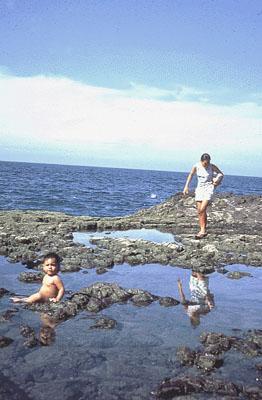
Coastecomate
Pronounced Koh-ah-stay-koh-MAH-tay, this small beachfront, is a few miles north of La Manzanilla. Sailboats fill the small, sheltered bay, and a three story, white stucco hotel occupies about half the beach. It has a thatched bar next to the swimming pool, and expensive look. Visitors told me rooms, with all meals and drinks, cost $150 USD a day. I sat by the pool and drank margaritas, while smiling fisherman came ashore with catches as tall as they were.
To get there
Take a northbound bus from Barra de Navidad or Melaque and get off at the junction of the road that goes into Coastecomate. Since the beach is located two miles from the main highway, along a very bumpy, and somewhat hilly road, I opted for a taxi from Melaque. As I walked out of town (intending to flag down a bus on the highway), I got a ride to Melaque in the back of a pickup truck.
Cuyutlan
This is more of a beach resort than a fishing village. Well-kept, three-story stucco hotels line a wide, half-mile boardwalk made of pastel pavers. Every few feet, vendors sell food and drink under faded beach umbrellas. I, personally, preferred the more tucked-in atmosphere of Barra de Navidad. Nevertheless, Cuyutlán offers a wide variety of lodging, and a bustling beachfront, especially during winter.
To get there
From the central terminal in Manzanillo, take a red and white bus to Ameria. Go across the street and walk back three blocks to the corner, where there are wooden logs for seats. Here a small, old bus with metal slab seats will take you to Cuyutlán for about one US dollar.


